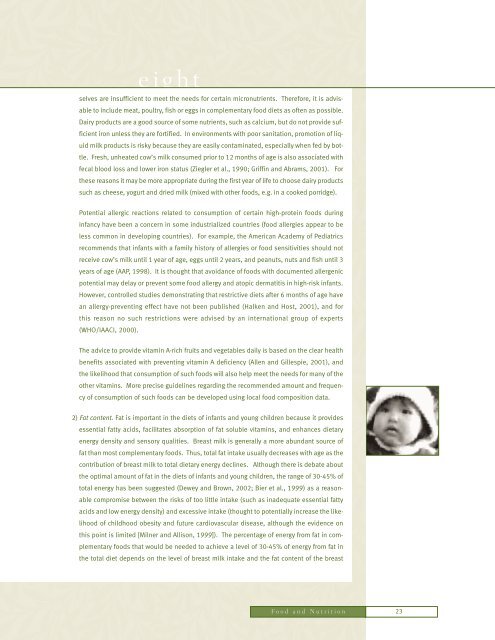Guiding Principles for Complementary Feeding of the Breastfed
Guiding Principles for Complementary Feeding of the Breastfed
Guiding Principles for Complementary Feeding of the Breastfed
Create successful ePaper yourself
Turn your PDF publications into a flip-book with our unique Google optimized e-Paper software.
eight<br />
selves are insufficient to meet <strong>the</strong> needs <strong>for</strong> certain micronutrients. There<strong>for</strong>e, it is advisable<br />
to include meat, poultry, fish or eggs in complementary food diets as <strong>of</strong>ten as possible.<br />
Dairy products are a good source <strong>of</strong> some nutrients, such as calcium, but do not provide sufficient<br />
iron unless <strong>the</strong>y are <strong>for</strong>tified. In environments with poor sanitation, promotion <strong>of</strong> liquid<br />
milk products is risky because <strong>the</strong>y are easily contaminated, especially when fed by bottle.<br />
Fresh, unheated cow’s milk consumed prior to 12 months <strong>of</strong> age is also associated with<br />
fecal blood loss and lower iron status (Ziegler et al., 1990; Griffin and Abrams, 2001). For<br />
<strong>the</strong>se reasons it may be more appropriate during <strong>the</strong> first year <strong>of</strong> life to choose dairy products<br />
such as cheese, yogurt and dried milk (mixed with o<strong>the</strong>r foods, e.g. in a cooked porridge).<br />
Potential allergic reactions related to consumption <strong>of</strong> certain high-protein foods during<br />
infancy have been a concern in some industrialized countries (food allergies appear to be<br />
less common in developing countries). For example, <strong>the</strong> American Academy <strong>of</strong> Pediatrics<br />
recommends that infants with a family history <strong>of</strong> allergies or food sensitivities should not<br />
receive cow’s milk until 1 year <strong>of</strong> age, eggs until 2 years, and peanuts, nuts and fish until 3<br />
years <strong>of</strong> age (AAP, 1998). It is thought that avoidance <strong>of</strong> foods with documented allergenic<br />
potential may delay or prevent some food allergy and atopic dermatitis in high-risk infants.<br />
However, controlled studies demonstrating that restrictive diets after 6 months <strong>of</strong> age have<br />
an allergy-preventing effect have not been published (Halken and Host, 2001), and <strong>for</strong><br />
this reason no such restrictions were advised by an international group <strong>of</strong> experts<br />
(WHO/IAACI, 2000).<br />
The advice to provide vitamin A-rich fruits and vegetables daily is based on <strong>the</strong> clear health<br />
benefits associated with preventing vitamin A deficiency (Allen and Gillespie, 2001), and<br />
<strong>the</strong> likelihood that consumption <strong>of</strong> such foods will also help meet <strong>the</strong> needs <strong>for</strong> many <strong>of</strong> <strong>the</strong><br />
o<strong>the</strong>r vitamins. More precise guidelines regarding <strong>the</strong> recommended amount and frequency<br />
<strong>of</strong> consumption <strong>of</strong> such foods can be developed using local food composition data.<br />
2) Fat content. Fat is important in <strong>the</strong> diets <strong>of</strong> infants and young children because it provides<br />
essential fatty acids, facilitates absorption <strong>of</strong> fat soluble vitamins, and enhances dietary<br />
energy density and sensory qualities. Breast milk is generally a more abundant source <strong>of</strong><br />
fat than most complementary foods. Thus, total fat intake usually decreases with age as <strong>the</strong><br />
contribution <strong>of</strong> breast milk to total dietary energy declines. Although <strong>the</strong>re is debate about<br />
<strong>the</strong> optimal amount <strong>of</strong> fat in <strong>the</strong> diets <strong>of</strong> infants and young children, <strong>the</strong> range <strong>of</strong> 30-45% <strong>of</strong><br />
total energy has been suggested (Dewey and Brown, 2002; Bier et al., 1999) as a reasonable<br />
compromise between <strong>the</strong> risks <strong>of</strong> too little intake (such as inadequate essential fatty<br />
acids and low energy density) and excessive intake (thought to potentially increase <strong>the</strong> likelihood<br />
<strong>of</strong> childhood obesity and future cardiovascular disease, although <strong>the</strong> evidence on<br />
this point is limited [Milner and Allison, 1999]). The percentage <strong>of</strong> energy from fat in complementary<br />
foods that would be needed to achieve a level <strong>of</strong> 30-45% <strong>of</strong> energy from fat in<br />
<strong>the</strong> total diet depends on <strong>the</strong> level <strong>of</strong> breast milk intake and <strong>the</strong> fat content <strong>of</strong> <strong>the</strong> breast<br />
Food and Nutrition<br />
23

















